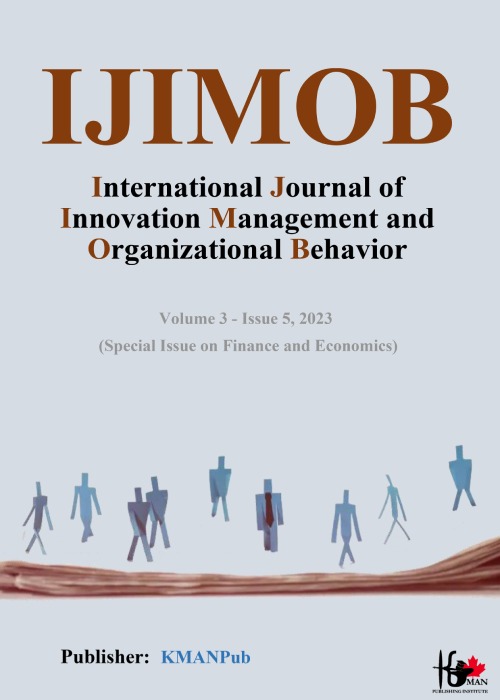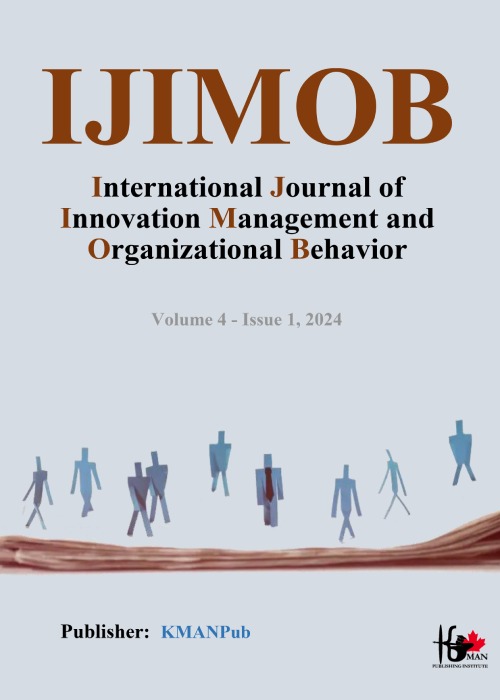فهرست مطالب

Journal of Innovation Management and Organizational Behavior
Volume:3 Issue: 5, Winter 2023
- Special Issue on Finance and Economics
- تاریخ انتشار: 1402/12/21
- تعداد عناوین: 5
-
-
Identifying the Executive Factors of Social Audit in Attracting Deposits and Reducing the Cost of Money in Bank using Grounded Theory MethodPage 0Objective
The purpose of this research is to identify practical indicators for the practical implementation of social audit in attracting deposits and reducing the cost of money in banks using the theoretical method.
MethodIn this research, using the qualitative research method of Strauss and Corbin (2011) grounded theory with the Nizamand method, the social audit model has been developed in attracting deposits and reducing the cost of money in banks. Therefore, in order to collect information from the statistical population used, which includes banking and university experts who have doctorate degrees in accounting, management, or economics, a semi-structured interview was conducted with 21 of them using purposive sampling, and the analysis of information in three The stage of open coding, axial coding and selective coding has been done.
FindingsAccording to the results of the data analysis of the interviews in three stages of open, central and selective coding, the category "social audit in attracting deposits and reducing the cost of money in the bank" was chosen as the central category, and this type of audit through evaluation and examining compliance with social responsibilities in terms of attracting low-cost deposits, reducing bank non-current claims, developing virtual banking services, respecting depositors' rights, respecting government rights, protecting the environment, reducing organizational administrative costs, and respecting competitors' rights is done
The causal conditions of the model include the need of the group of shareholders, the government, depositors and environmentalists for social intelligence information in attracting deposits and reducing the cost of money in banks, and the strategies for conducting this audit also include optimizing corporate governance in banks, creating anti-corruption committees, Fraud and money laundering, government incentive policies, continuous training of employees, respecting the interests of all stakeholders and giving importance to high cultural and social values in the workplace. Also, factors such as the lack of attention to transparency and greater profitability in state banks, government laws, the complexity of the nature of social audit implementation, and the lack of accounting and social audit standards were the most important intervening factors that affect the model's strategies.ConclusionIn the country of Iran, if the executive factors of social audit in attracting deposits and reducing the cost of money, which have been identified during the development of the model in this research, will be implemented by the banks. It can be ensured that the banks fulfilled their social responsibilities in the field of attracting deposits, which prevented their bankruptcy in the first stage and prevented social financial crises in the society in the second stage.
-
Pages 1-9Objective
The aim of this research is to identify financial and non-financial metrics that affect companies' sustainability performance, which can be utilized to develop current financial reporting in order to provide comprehensive information on companies' performance to assist in better decision-making.
MethodThe present study was conducted using the thematic analysis method and MAXQDA 2020 software. The research population consisted of experts (university faculty members, students, and doctoral graduates in finance, economics, accounting, and management), selected through snowball sampling. Data were collected through semi-structured interviews with experts until theoretical saturation was achieved. In this study, theoretical saturation was confirmed after conducting 26 interviews.
FindingsIn these interviews, experts suggested various financial and non-financial metrics in economic, social, and environmental dimensions for measuring and reporting companies' sustainability performance. Economic metrics include sales growth, research and development, liquidity growth, financial leverage, company growth opportunities, industry competition, intangible assets, gross domestic product, company age, financial incentives, CEO duality, stock liquidity, board independence, corporate governance, ownership structure, company size, return on equity, economic value added, earnings per share, and return on assets. Social metrics include ethical conduct, job security for employees, and corporate social responsibility, while environmental metrics mentioned by most experts include waste and effluent management and clean (green) production.
ConclusionIt can be concluded that considering globalization and attention to social and environmental issues and responsibilities alongside corporate profitability goals, and the necessity of considering stakeholders' interests in the new corporate governance doctrine, reporting on companies' sustainability performance is not only a need but a necessity for companies in the global competitive arena and as a strategic advantage.
Keywords: Sustainability, Stakeholder Theory, Signaling Theory, Corporate Social Responsibility -
Pages 10-22Objective
This research aims to investigate the fluctuations of parallel markets on the level of penalty rates and to propose a conceptual model predicting depositors' behavior regarding deposit failure rates. Theoretically, this study contributes to the development and presentation of factors affecting customers' financial behavior in the banking system (both private and public). From an innovation perspective, the proposed model examines the actual decisions and behaviors of individuals in financial matters.
MethodThe research methodology is applied and post-event in nature. This study adopts a quantitative approach. The data used in this research were collected by referring to time series statistics from the central bank, official bank websites, and the country's capital market and were utilized accordingly. The software used for data analysis in this research is Eviews.
FindingsAfter the necessary data examination and analysis using the software, the results of this research indicate that in the first phase, the optimal portfolio was determined between currency rates, gold coins, real estate, securities, and bank deposits without imposing any penalty on long-term deposits. In this situation, individuals with different risk levels allocate 95%, 57%, and 37% of their portfolio to bank deposits, corresponding to risk-averse, moderate risk, and risk-seeking individuals, respectively. In the second phase, by imposing a penalty equal to 10% of the deposit profit, the optimal basket was determined; even in this case, these three groups of individuals with different risks allocate 88%, 53%, and 36% of their capital to bank deposits, respectively.
ConclusionIt is observed that this decreasing trend in bank deposits continues until the penalty rate equals 25% of the bank deposit rate, beyond which no individual with any level of risk is willing to deposit in the bank.
Keywords: Penalty Rate for Withdrawal, Long-term Deposits, Model Presentation, Iranian Banking System -
Investment Management with Innovation in Neural Networks and Metaheuristic AlgorithmsPages 23-28Objective
Considering the issue of selecting an optimal and desirable stock portfolio, which all investors, both individual and institutional, face.
MethodThe purpose of the current research is to present trading systems with innovation based on neural networks and metaheuristic algorithms grounded in technical analysis. Therefore, the criteria affecting stock selection in technical analysis have been examined. Consequently, from among the companies listed on the Tehran Stock Exchange during the years 2011 to 2021, 135 companies were selected as samples through a systematic elimination method and analyzed using a combination of innovative neural network methods and metaheuristic algorithms.
FindingsThe results have shown that such a trading system produces comparable or better results compared to Buy & Hold and other trading systems for a wide range of stocks even over relatively longer periods.
ConclusionFor future work, it is planned to focus on combining more technical parameters and using convolutional neural networks (CNN) or other deep neural network models.
-
Pages 29-35Objective
The purpose of this research is to identify and prioritize the factors affecting women's entrepreneurship.
MethodologyThis study is applied in aim and descriptive in method. To determine the weight of criteria and sub-criteria for this issue, the Fuzzy Analytic Hierarchy Process (FAHP) was utilized. Accordingly, after identifying the criteria and sub-criteria for each, a questionnaire was designed to match them and distributed to experts. In the current issue, the effects of criteria affecting women's entrepreneurship were examined with 20 decision-makers. In the next step, the questionnaires filled out by experts were transferred to Excel software.
FindingsThe factors affecting women's entrepreneurship include five criteria consisting of family, personality, economic, social, and cultural criteria. The family criterion has eight sub-criteria, the personality criterion has ten sub-criteria, the economic criterion has seven sub-criteria, and the social and cultural criteria each have five sub-criteria. The results show that among the criteria, the "personality" criterion, with a weight of 0.3071, and the "cultural" criterion, with a weight of 0.1103, ranked first and last, respectively. In addition, the "economic" criteria with a weight of 0.2011, "family" with a weight of 0.1931, and "social" with a weight of 0.1884, are ranked second to fourth, respectively. Moreover, among the thirty-five sub-criteria, the sub-criteria of "extensive social relationships" with a weight of 0.0530, "job satisfaction" with a weight of 0.0462, "institutions and resources" with a weight of 0.0448, "determination and will" with a weight of 0.0444, and "guidance and leadership" with a weight of 0.0428, are ranked first to fifth, respectively. Also, the sub-criteria of "market access" with a weight of 0.0270, "role models" with a weight of 0.0165, "transportation system" with a weight of 0.0165, "role conflict" with a weight of 0.0135, and "marital status" with a weight of 0.0088, respectively rank thirty-first to last.
ConclusionThe research underscores a strong correlation between personality traits and women's entrepreneurship, pointing to the necessity of tailored programs in higher education to foster entrepreneurial inclinations.
Keywords: Women's entrepreneurship, Family criteria, Personality criteria, Economic criteria, Social, cultural criteria


